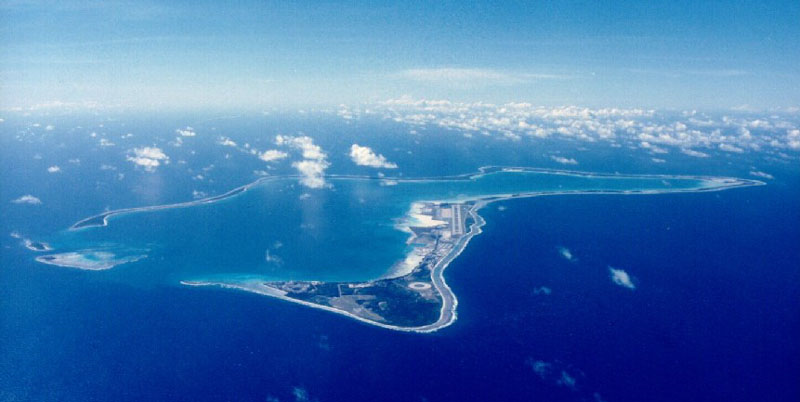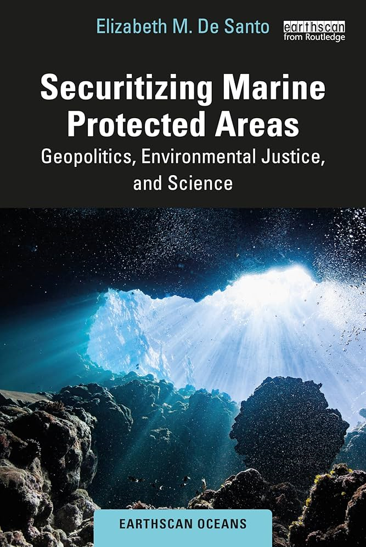Marine protected areas (MPAs) are widely considered to be the best tool to protect ocean biodiversity. Generally speaking, an MPA is an area of the “ocean set aside for long-term conservation aims” (IUCN, 2017), although many other types of ocean protection fall into this category, including marine reserves, marine sanctuaries, or marine parks, all of which can have different objectives and levels of protection. A significant increase in establishment of MPAs has occurred over the past two and a half decades, due to a combination of climate change, biodiversity loss, and increasingly ambitious global conservation targets to address the two threats. As environmental issues are more and more politicized, this book argues that MPAs are becoming increasingly “securitized,” that is, MPAs are deployed as a response to the global security threat of climate change (p.10). Dr. De Santo outlines how MPAs are created for more than biodiversity protection, though; they can also serve as a tool for political gains, environmental (in)justice, and provide a mechanism with which to examine information pathways at the nexus of science and policy. The book draws on De Santo’s numerous years of research and experience in both national and international contexts to examine the implications of securitizing MPAs, which are presented in three sections: 1) geopolitics; 2) environmental justice; and 3) science. These explorations are situated against the new Biodiversity Beyond National Jurisdiction (BBNJ) Treaty, which provides the means to establish MPAs in Areas Beyond National Jurisdiction (ABNJ), and are anchored by case studies related to human rights, misinformation, and military tensions.
Geopolitics
The first section of the book examines rising military tensions and the role of establishing MPAs in overseas territories (OTs) to secure a foothold in advantageous locations. Chapter 2 describes the global arm-wrestling match that is the relationship between China and the US: establishing oil rigs and sending warships into contested waters, fortifying remote islands for military purposes, and strategically befriending each other’s enemy’s enemies. Chapter 3 examines how the OTs of France and the United Kingdom provide a mechanism to access resources and establish a presence in regions far from their own territories. While dense, these chapters illustrate how, within this increasingly fraught backdrop, MPAs established in these contentious regions are not only prioritized for their conservation value, but also their “geostrategic value” and ability to be “repurposed for action if needed” (p. 37).
The second section opens with a sobering examination of the establishment of the Chagos MPA, a process fraught with human rights violations, legal battles, and discriminatory, colonial practices at the hands of the UK and the US. Dr. De Santo guides readers through the expulsion of the Chagossian people from their island home in the name of conservation, the subsequent, unsuccessful legal battles to reestablish residency on the island of Diego Garcia, and the eventual passing of the Chagos Archipelago from UK control to Mauritius. She also considers the role of BINGOs (Big International Non-Governmental Organizations) and their potential to oppress local rights in the name of environmental protection. While the Chagos MPA is an extreme example, the underlying issue presented (e.g., expropriation in the name of conservation), is not uncommon. Chapter 5 analyzes ocean management practices and their alignment with the three pillars of environmental justice: 1) access to information; 2) participation in decision-making; and 3) access to justice, leaning on best practices for stakeholder engagement and case studies from Australia, California, and the UK in the establishment of MPA Networks.
Science
The final section focuses on science, namely, managing uncertainty and misinformation, implementing the precautionary approach, and identifying effective pathways between science and policy. Through several Canadian case studies, De Santo demonstrates the importance of consistent messaging, process transparency, and effective pathways for science advice in the MPA establishment process. This section speaks to the inherent complexities that exist in conservation planning, including access and misinformation, and how these complexities will be exacerbated in ABNJ.
This book comes at an interesting moment in marine conservation. In the run up to 2030, MPAs are being established rapidly and under extreme political pressure. Government agencies responsible for MPA establishment will be managing increasingly large areas of the ocean and all functional areas will be impacted: enforcement, operations, monitoring, research. These agencies are also tasked with doing this work quickly, equitably, effectively, and transparently. Given this context, I found some of the recommendations in the book to be somewhat optimistic. For example, advising the conservation community to look beyond the “low-hanging fruit” (p.173), e.g., areas away from heavier marine use. It can be a significant financial and administrative burden to accept liability for areas that are heavily used, not to mention management of the complexity of multiple stakeholders, partners, and users in a process that is under an increasingly tight deadline. I was also surprised that Parks Canada National Marine Conservation Areas (NMCAs) were not mentioned in a more fulsome way. Parks Canada is specifically mandated to create NMCAs in co-management agreements with Indigenous communities, an approach generally accepted to improve ecological and social outcomes of MPAs (Ban et al., 2011; Voorberg and Van der Veer, 2020). Indeed, Gwaii Haanas National Park Reserve, National Marine Conservation Area Reserve, and Haida Heritage Site is the only co-managed, federal marine conservation area in Canada (Ban et al, 2018). In terms of access and environmental governance, the unique establishment and management of Gwaii Haanas may have been a worthwhile case study to explore in this book.
In general, I found this book to be a comprehensive, novel examination of MPAs through three lenses that will become increasingly relevant as MPA establishment multiplies over the next five years. I also thought weaving the context of the BBNJ Treaty into the study was an important angle to maintain throughout the book, particularly as the treaty reaches ratification in the next several years. As a policy analyst working on Canadian federal marine conservation initiatives, I found the book approachable, and I gained new insights that will be applicable for my work as an early career professional. Broadly, this book speaks to the dynamic nature of MPAs and the different roles they play in an increasingly politicized sea-scape, as well as lessons learned to ensure equity and success in future conservation initiatives.
References
Ban, N. C., Adams, V. M., Almany, G. R., Ban, S., Cinner, J. E., McCook, L. J., Mills, M., Pressey, R. L., & White, A. (2011). Designing, implementing, and managing marine protected areas: Emerging trends and opportunities for coral reef nations, Journal of Experimental Marine Biology and Ecology, 408(1-2), 21-31. https://doi.org/10.1016/j.jembe.2011.07.023
Ban, N. C. & Frid, A. (2018). Indigenous peoples’ rights and marine protected areas. Marine Policy, 87, 180-185. http://dx.doi.org/10.1016/j.marpol.2017.10.020
De Santo, E. M. (2024). Securitizing marine protected areas: Geopolitics, environmental justice, and science. New York: Routledge. xxiii, 189 p. ISBN 978-1-00-319052-3.
International Union for the Conservation of Nature (IUCN). (2017, November). Marine protected areas and climate change. Issues Brief. Gland, Switzerland: IUCN. https://iucn.org/sites/default/files/2022-07/mpas_and_climate_change_issues_brief.pdf
Voorberg, W., & Van der Veer, R. (2020). Co-management as a successful strategy for marine conservation. Journal of Marine Science and Engineering, 8, 491. https://doi.org/10.3390/jmse8070491
Author: Hali Moreland (Revelstoke, BC; hali.moreland@dal.ca)
Image credit: View of Diego Garcia, Chagos Archipelago by Steve Swayne.
Creative Commons Attribution-Share Alike 2.0 Generic license
Tags: Marine & Coastal Issues; Public Policy & Decision-Making; Science-Policy Interface

